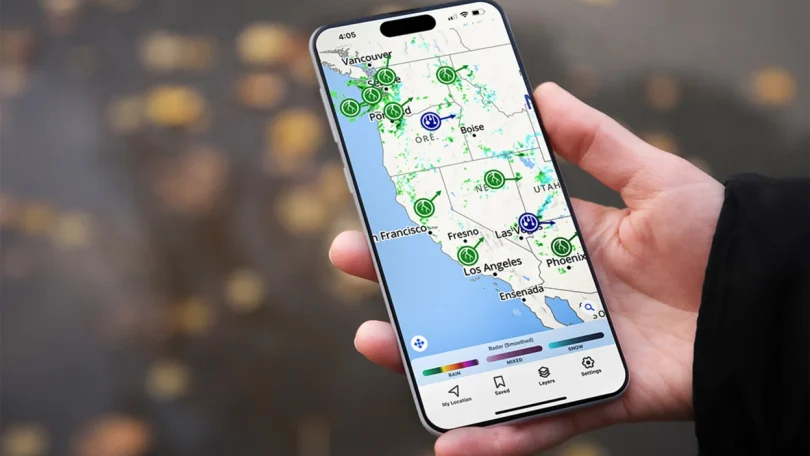Thunder rattles the windows, rain starts to needle the glass, and the plan for the evening shifts in minutes. Power may flicker, mobile towers can get crowded, and the screen people rely on for updates suddenly has to do more with less. A phone that feels smooth on a clear night can turn sluggish in a storm – bright screen, noisy apps, and a maze of tabs that pull attention away from what matters. This guide cuts that chaos. It lays out a routine that keeps one clean path to the score, trims the noise that eats battery, and helps the device stay readable, dry, and dependable while the weather does its thing. The aim is simple – steady checks, fewer mistakes, and a calmer room when thunder makes everyone jump.
Prep Before Skies Turn
Set the base while the forecast still looks vague. Free a couple of gigabytes so short clips and app fixes land cleanly, then update the phone on home Wi-Fi. Wipe the lenses, lower brightness one notch indoors to limit heat, and move three apps to row one in this order: notes, live scores, messages. Pin a tiny note titled “Tonight” and write the match name at the top so the brain has one task to pursue under pressure. Turn on Do Not Disturb for the likely game window while allowing starred contacts; this keeps banners from covering scorecards just as a wicket falls. Put a slim power bank by the door and drop a clean cloth in the pocket so rain doesn’t fog the camera the moment the door opens for a signal check.
Give the score a trusted doorway. In the pinned note, save a single board that loads fast and looks the same every time, then open it from there – never from rush searches that invite look-alike pages. During a lull in the storm, that routine turns into one steady motion: glance, read, close. If a clear one-page feed helps you hold focus, keep it in that note and refer to it in natural prose – a quick check at read more inside the sentence does the job without dangling a naked link or sending thumbs on a detour. With one path and one habit, the score feels like a heartbeat rather than a hunt.
Public Networks When Outages Hit
Storms push everyone onto whatever connection will work, which raises two risks at once – weak links and odd portals. Treat public Wi-Fi like a crowded lobby: fine for reading, poor for private steps. Join only the exact network name staff confirm, and if a splash page asks for a social login that makes no sense for basic access, back away and switch to carrier data for anything tied to identity. Keep installs for home, where speed is steady and attention is higher. To make this feel natural, fold a short, in-text checklist into your storm routine so it reads as part of the moment rather than as a separate chore:
- Reach scores through the pinned note, then pocket the phone to cool between checks.
- Lock orientation so a bump or gust doesn’t flip the view at the worst second.
- Angle the screen away from windows and strangers to keep prying eyes off alerts.
- Turn off autoplay previews to save bandwidth for the live card that matters.
- If the page looks odd, close it and re-enter through the saved link instead of guessing.
These moves turn frantic taps into calm beats, even when a café goes whisper-quiet after a loud crack of lightning.
Power, Heat, And Moisture — Keep The Phone Alive
Thunderstorms are hard on batteries because screens run bright, radios fight congestion, and warm, damp air slows everything down. Charge to full before the first over and keep the bank handy, so the device doesn’t limp at 10% during a tight chase. Use wired or stable earbuds, so sound stays clear at lower volume; repeated reconnects waste energy. If the phone feels hot, lock it and set it flat on a dry surface away from the window – temperature drops fast once glass leaves direct light and wind. Dry hands before each check; water on skin tricks touch sensors and turns simple swipes into messy loops. Store the phone in an inner pocket between glances so wind-blown mist doesn’t crawl under the case. Little acts like these add up to a screen that still responds when the room needs it most.
Focus And Boundaries When Weather Distracts
Storm noise plays tricks on timing – a long roll of thunder, a flash at the corner of the eye, and suddenly an impulsive tap opens a tab that doesn’t belong. Cut the pull by limiting options. Keep only three apps in recent: the pinned note, scores, and messages. Mute lively group chats for two hours so play-by-play happens on the field, not the lock screen. If power blips and the router cycles, resist the urge to chase Wi-Fi bars on a balcony; switch to mobile data, take the update, and wait for the network to settle. Indoors, read the room – dim lights, lower TV volume a notch, and let the scorecard set the pace, so people talk rather than shout over wind and rain. Boundaries like these calm the air inside while the sky does drama outside.
After The Storm, Keep The Calm
Wrap with a pass that makes the next rough evening easier. Save one screenshot of the final board to a small “Storm Nights” folder, so context is ready next time. Clear recent apps to stop background pulls, return brightness and alerts to normal, and dry the case with that cloth you carried. Replace any tab that felt off with a source you trust while the event is fresh in mind. The whole point is rhythm – one note, one link, one path that works whether the sky grumbles or clears. With this setup, storm evenings become manageable: the score appears on cue, the room stays steady, and the phone helps without stealing the moment, which is exactly what everyone needs when weather takes center stage.







